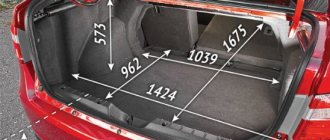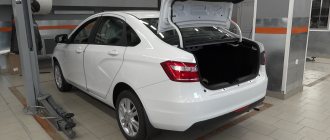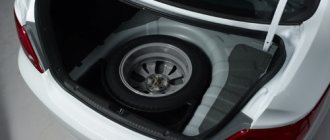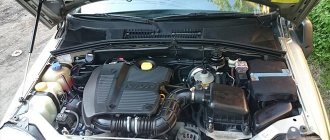Most recently, the Russian AvtoVAZ presented its new product – Lada Vesta SW Cross. The trunk volume of a Lada Vesta SV Cross car is relevant information for motorists who are often forced to transport large and heavy loads, for example to a summer cottage. The designers of the plant distributed the space in the trunk, which only increases over the years, very rationally. For example, in 2016, Vesta’s luggage space allowed it to accommodate up to 400 liters of various cargo. The new model has a more capacious trunk of 480 liters. In addition, it can be expanded to 825 liters by folding the rear seats.
General information
Always first judge by official information from the dealer. Lada Vesta SW Cross offers us the following trunk dimensions:
- to the curtain with the raised floor installed – 385 l;
- with the raised floor removed – 480 l;
- folding the second row seats and removing the false floor - 825 liters.
We are talking about the spacious space under the raised floor - 95 liters. Such a solution is quite extraordinary. Although, with an eye to the quick dismantling of the structure, there will be no difficulties in transformation. The seats fold using 60/40 technology - a flat floor is not for this car.
Let's move on to the following parameters of the Lada Vesta SV Cross trunk:
- height -860 mm;
- width – 1000 mm.
The size of the trunk will vary depending on the points that are taken as the unit of reference. Despite such features, the manufacturer still guaranteed the specified parameters in some places. Buyers can confidently expect to receive what the dealer promises them when selling the car.
Powertrains and transmission
Car power unitToday, Lada Vesta is equipped with two four-cylinder 16-valve gasoline engines:
- the base 1.6-liter power unit has a capacity of 106 “horses”;
- a more powerful 122-horsepower engine of 1.8 liters in volume.
Vehicle performance depends on many factors, including the selected transmission.
| 106 hp, 1.6 l, manual transmission | 106 hp, 1.6 l, robot | 122 hp, 1.8 l, robot | |
| Acceleration 0-100 km/h (s) | 11.2 | 14.1 | 12.1 |
| Maximum speed (km/h) | 175 | 178 | 186 |
| Average fuel consumption per 100 km (l) | 6.9 | 6.6 | 7.2 |
Personal measurements
The manufacturer is always trying to lie somewhere. This is done as a marketing ploy, so you will have to personally take measurements to get real numbers. The trunk volume really matches the data of 385 liters. Trips to the store or to the country will not cause difficulties. Carrying your own winter wheels is another matter, but there is some space due to the raised floor, which allows you to cope with seasonal tasks.
Comparison with competitors
| UNIVERSALS | |||||||||
| Lada Vesta Cross | Lada Priora | Lada Kalina | Lada Largus | Skoda Octavia | Ford Focus | Kia See'd SW | Hyundai i30 | Chevrolet Cruze | Citroen C5 |
| 575 | 444 | 361 | 560 | 588 | 476 | 528 | 528 | 500 | 505 |
The Lada Vesta SW Cross is a roomy car (825 liters) with the second row of seats folded down. For example, a 65-inch TV is placed in the cabin without the risk of damage.
It is possible to add additional shock-absorbing material. Single-chamber refrigerators are also transported by station wagon if necessary. Photos confirming such possibilities are available on many websites dedicated to the domestic automobile industry.
Other parameters for the trunk:
- the width between the arches is 980 mm;
- when measuring the width from the side niches - 1340 mm;
- length to the driver's seat moved forward all the way – 1820 mm;
- length to the back of the rear seats – 930 mm;
- with the second row folded, the height to the ceiling is 830 mm.
Loading is always easier to do with a low threshold. Lada Vesta SW Cross shows 110 mm in threshold height. It will not be difficult for men to overcome this milestone. We are still talking about SW Cross with increased ground clearance, which affects the height of the trunk from the ground, so women will have to make a significant effort to pack bags from the store.
New AvtoVAZ
The new Lada Vesta model in a “universal” body has long been discussed in media sources and on automotive Internet portals. Photos of the Lada Vesta in its new guise presented on websites have caused heated discussions among car enthusiasts. Photos of the interior are very similar to the current interior of the sedan. The similarity in size and appearance is largely due to the fact that the station wagon will be assembled at the same plant in Izhevsk where the sedan is currently being assembled.
Most likely, the new Lada Vesta, like the sedan, will be equipped with three configuration options. What a real station wagon will look like will become known in the near future. The start of sales is scheduled for this fall.
Raised floor
It’s worth studying the raised floor in more detail. Many people will not be able to understand this feature right away. Why create such a complex design given the characteristics of a station wagon? The question has many answers.
Firstly, a distinctive feature appears from many competitors, which creates the necessary marketing ploy. Secondly, there are two independent compartments that separate different chemicals and tools from each other.
The raised floor received the following dimensions:
- height with a cover – 80 mm;
- height with cover removed – 110 mm;
- length – 940 mm;
- width – 900 mm.
The raised floor structure is removable. The main frame is simply inserted into the slots provided for it. Despite the careful attitude to space, the developers made the fastenings and frame themselves massive, which takes up a little useful space.
Thanks to modern composite materials, everything can be made much more compact, but it is worth considering the emphasis on saving money - overpayment is a critical moment for citizens. The designers' decision can be justified.
LADA Vesta SW – Technical characteristics – Official LADA website
- Wheel formula / drive...
- Body type / quantity...
- Length / width / height, mm
- Front/rear wheel track,…
- Luggage compartment volume, l
- Engine
- Quantity, location...
- Maximum power, kW (hp) / rev….
- Maximum torque, Nm / rev….
- Dynamic characteristics
- Maximum speed, km/h
- Acceleration time 0-100 km/h, s
- Fuel consumption
- Extra-urban cycle, l/100 km
- Technically permissible maximum weight...
- Maximum trailer weight without brake system /…
- Transmission
- Main gear ratio...
- Suspension
- Steering
- 1.6 l 16 cl. (106 hp), 5MT
- sedan / 4
- 5
- 4410 / 1764 / 1497
- 2635
- 1510 / 1510
- 178
- 480
- 21129
- petrol
- 4, in-line
- 1596
- 78 (106) / 5800
- 148 / 4200
- gasoline 92
- 182
- 11,2
- 9,3
- 5,5
- 6,9
- 1230…1380
- 1670
- 450 / 900
- 55
- 5MT
- 3,9
- 1.8 l 16 cl. (122 hp), 5AMT
- 1.6 l 16 cl. (106 hp), 5AMT
- 1.8 l 16 cl. (122 hp), 5MT
Fuel consumption data is determined under standardized conditions using special measuring equipment, in accordance with the requirements of GOST R41.101–99 (UNECE Rules No. 101). Used to compare cars from different automakers. They are not an operational standard.
- Body
- Wheel formula / drive...
- Body type / quantity...
- Length/width/height by antenna,…
- Front/rear wheel track,…
- Luggage compartment volume in passenger/cargo…
- Engine
- Quantity, location...
- Maximum power, kW (hp) / rev….
- Maximum torque, Nm / rev….
- Dynamic characteristics
- Maximum speed, km/h
- Acceleration time 0-100 km/h, s
- Fuel consumption
- Extra-urban cycle, l/100 km
- Weight
- Technically permissible maximum weight...
- Maximum trailer weight without brake system /…
- Transmission
- Main gear ratio...
- Suspension
- Steering
- Tires
- 1.6 l 16 cl. (106 hp), 5MT
- station wagon / 5
- 5
- 4410 / 1764 / 1508
- 2635
- 1510 / 1510
- 178
- 480 / 825
- 21129
- petrol
- 4, in-line
- 1596
- 78 (106) / 5800
- 148 / 4200
- gasoline 92
- 178
- 12,4
- 9,5
- 5,9
- 7,3
- 1280…1350
- 1730
- 600 / 900
- 55
- 5MT
- 3,9
Trunk structure of Lada Vesta SV Cross
Niches are located on both sides of the trunk as standard. Here you can find camping supplies, a fire extinguisher, and a flashlight. Even more things are fixed through many hooks scattered on all surfaces. A small mesh stretches along the left niche, and a large one from the beginning of the tailgate to the backs of the second row seats (fixing large suitcases and bags).
At night, two light bulbs will illuminate the trunk space. They are located parallel on both sides of the arch. If you need to pump up the tires or turn on another device, there is an outlet on the right side. Its height allows you to connect electrical appliances without the risk of damaging the cable.
Comparison with competitors
Vesta's competitors include:
Let us remind you that the trunk volume of a Russian car is 480 liters for both a sedan and a station wagon. In Renault Logan, the volume of this department reaches 510, and in Rio - 500 liters. Solaris will allow you to load only 470 liters of luggage, although both of these models are created on the same platform. The leaders in trunk capacity are the Skoda Rapid and Datsun, which hold 530 liters.
If we compare the features of the luggage compartments, then the Datsuns also have a good and flat floor, and the loading height is optimal. But the arches in Datsuns protrude too much, and the opening width is not enough to load particularly large items.
In this regard, the Solaris trunk causes the most inconvenience: the wheel arches here are the largest, which does not have the best effect on the geometry of the sidewalls. These shortcomings are somewhat concealed due to neat hinges, a flat floor, low loading height and a large opening. Rio, created on the same site as Solaris, has the same advantages and disadvantages, but the usable luggage compartment volume of this car is larger.
Rapid, in addition to the advantages noted by its competitors, has a functional door-lid that, when opened, forms the highest opening for loading. The disadvantage is the threshold height, which is much higher than that of rival models.











